One of the most active areas of research and development at the moment is in the push towards self driving cars and autonomous transportation.
Should self driving cars be realized it will free up time and reduce stress levels on the daily commute. If perfected it may also be safer than cars being driven by humans.
Electric powered autonomous shuttles replacing gas guzzling cars could also have a significant, positive impact on the environment.
It is no wonder, therefore that many of the leading players in the autonomous sector, as well as many major car manufacturers, are investing significant amounts of time and expense into developing smart self driving and autonomous solutions.
The following list is organized alphabetically and will look at 33 of the leading companies who are currently pioneering self driving car technology.
Table of Contents
Apple

In June 2019, Apple confirmed it has acquired Drive.AI. a self-driving startup that was once valued at $200 million which was in the in midst of closing down. And has hired dozens of Drive.ai self driving engineers.
According to Axios’ sources, Apple purchased the company’s assets, including its autonomous cars and other assets.
Why it matters: The deal and hires confirm that Apple hasn’t given up its self driving project.
Since 2016 there has been much interest surrounding Project Titan. This is the name given to Apple’s development program for self driving cars.
However the drive for autonomous cars did not get off to a smooth start. Early setbacks, such as a rumoured hiring freeze following the departure of project head Steve Zadesky hit the program.
There was also a rumour of uncertainty within Apple regarding the vision of the project.
Since then Apple has tasked Bob Mansfield, a noted hardware executive, with leading their charge towards developing self driving cars.
The subsequent appointment of Dan Dodge, the founder and former CEO of QNX indicates that Project Titan now has a firm strategy.
This means that Apple is focusing the majority of its efforts on the development of autonomous or self driving cars.
Apple documents released in April 2017 revealed that the company was working towards creating an “automated system”.
Recruiting Self Driving Car Experts from Waymo
To help further their quest towards achieving self driving cars Apple also revealed that they had conducted a recruitment drive.
This has seen the company hire some former Waymo and NASA’s robotic engineering experts amongst others.
The most notable of these recruits was Jaime Waydo, a senior engineer who had worked at NASA’s Jet Propulsion Laboratory as well as on various Waymo projects.
This recruitment drive has served to kick start Project Titan. Following the arrival of the new recruits, vehicular patent activity connected to Apple has noticeably increased.
Apple Testing Self Driving Car Fleet
Since 2018 Apple has been fleshing out its autonomous cars fleet. In the summer of 2018 the company officially had 66 vehicles registered with the California DMV most of which were also operating on public roads around the state.
This means that Apple has the third largest fleet of self driving cars in California, behind only Waymo and GM Cruise.
During 2018 it was also reported that Apple was looking to use self driving cars for the purposes of moving employees between corporate facilities.
This would mean that while the autonomous technology would be in charge of the vehicle each of the Volkswagen T6 transporter vans would also have a human driver present behind the wheel just in case any issues should arise.
Furthering the push towards self driving cars Apple reportedly aims to begin shipping autonomous cars in 2020.
Aptiv
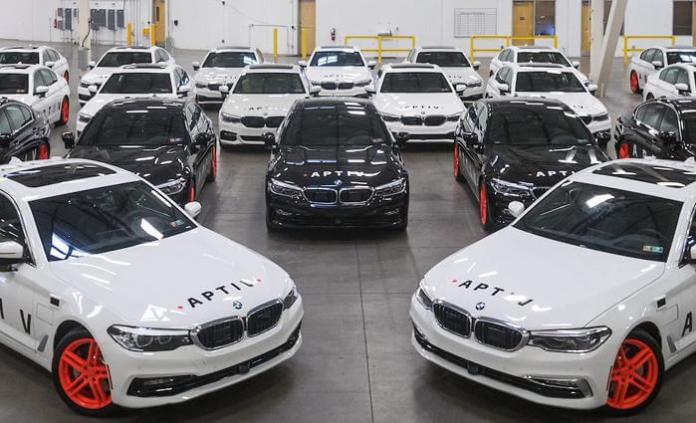
Aptiv was established in 2017 as a branch of Delphi Automotive’s powertrain division. Originally named Delphi Technologies the company soon rebranded to the now familiar name of Aptiv.
It was hoped that the new name would help to highlight the companies work in electrical components, software and, particularly, autonomous cars.
Instead of building self driving cars from scratch Aptiv has created a system of sensors and autonomous software that can be fitted onto a range of existing car models. Once fully fitted the cars are capable of self driving.
Aptiv and its predecessors at Delphi Automotive have also developed an autonomous self driving concept, which was previewed at CES 2016.
This is a human-machine interface and is intended to bridge the gap to Level 5 automation, in other words, a completely self driving car.
Aptive hopes that this interface will help consumers develop trust in self driving cars whilst also remaining vigilant enough to be able to take action should the need arise.
nuTonomy branded cars
 Delphi has also aided Aptiv’s goal of getting their own brand self driving cars onto the roads by acquiring nuTonomy for $400m.
Delphi has also aided Aptiv’s goal of getting their own brand self driving cars onto the roads by acquiring nuTonomy for $400m.
NuTonomy is a leading autonomous software development hub.
They also have a proven track record in the world of autonomous cars.
In 2016 nuTonomy integrated self driving cars and the surrounding technology into a Singapore based taxi service.
Additionally, they have also tested similar technology on the streets of Boston, Massachusetts, the first company to do so.
Since acquiring nuTonomy Delphi and Aptiv were selected by Singapore’s Land Transit Authority to pioneer an autonomous mobility program.
They are also drawing up plans for autonomous taxis to be piloted both in the US and Europe.
Partnerships with Lyft and others
Another partnership with Quanergy Systems has allowed Aptiv and Delphi to develop solid state lidar.
If used in autonomous systems this technology could help to lower the cost of self driving cars and other autonomous technology.
CES 2018 saw Aptiv taking delegates to the conference on around 400 Level 4 automated rides to a range of destinations around the Las Vegas strip.
This was achieved in partnership with another self driving pioneer, Lyft.
Aptiv hopes to have its models and autonomous systems scaled for production by the end of 2019 while Lyft has reported having successfully completed over 5000 trips in cars using Aptiv’s self driving technology.
Audi

In recent years car giants Audi has unveiled a series of self driving cars using models and technology derived from their noted A7 and RS7 models.
These have included a number of autonomous test vehicles intended for the consumer market.
Since July 2016 Audi has, like many other larger players in the motor industry, operated their own autonomous subsidiary, SDS Company.
Like similar subsidiaries, the aim of SDS Company is to pioneer developments in self driving cars and related technology for the benefit of Audi.
Furthering this goal Alexandre Haag was appointed the CTO of the subsidiary. Haag is a former program manager with Tesla Autopilot.
Controversial Self Driving A8

Like other companies, Audi hopes to commercialize autonomous technology in their next-generation A8 fleet.
The Audi A8 is marked to be the company’s new flagship range delivering not only a great driving experience but showcasing their technological advances.
The Audi A8 is controversial in some circumstances as it’s autonomous driving feature lets drivers take their hands off the wheel up until the speed of 37 mph.
When the Audi A8 was first unveiled it was the first of the self driving cars that actually allowed drivers to drive hands free.
Currently, this technology is only licenced in Europe however the company is working towards making it available to consumers in the US and other markets.
Self Driving technology used within the Volkswagen group

Any developments made here won’t be confined solely to Audi’s luxury brand. The company operated under the Volkswagen Group umbrella, as is Daimler and BMW.
This means that any developments made by Audi and SDS company can be implemented across a wide range of organisations.
The German consortium that runs Audi has recently acquired Nokia’s HERE precision mapping assets.
This acquisition could help the drive towards self driving cars make a significant step forward.
HERE has been making a series of strides in the designing of open specifications for vehicle sensor data that is collected and transmitted to the cloud.
Just this month Audi has pledged to invest over $15 Billion in self driving and electric cars.
Baidu

Chinese company Baidu made its name as an internet search engine company. However, in 2014 the company announced a partnership with BMW.
The aim of this partnership is to develop a semi-autonomous prototype.
The self driving cars that the partnership we’re able to develop were tested on some of China’s highways to much fanfare.
However, the potentially successful collaboration ended with the two companies parted way in 2016 after a series of disagreements concerning future strategies.
Baidu has not let this separation dent their progress.
Mass Producing Self Driving Cars in 5 Years
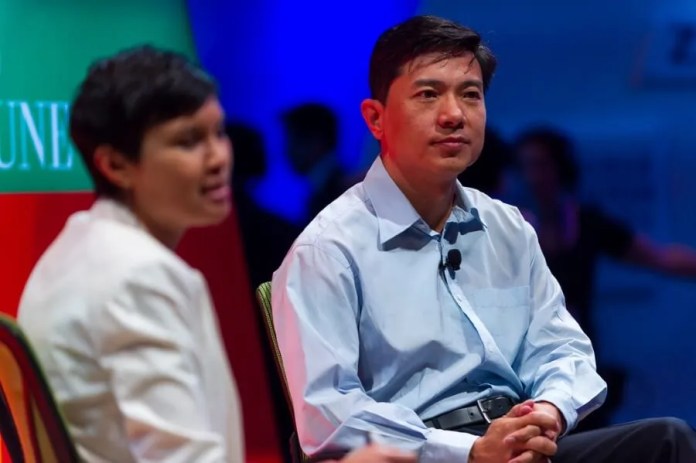
In June 2016 Robin Li, the CEO and co-founder of Baidu, announced that the company had set a 5 year goal for mass producing self driving cars.
Helping to drive them towards this goal is their newly opened AI research lab located in Silicon Valley. Here they are developing Level 4 autonomous vehicles.
Since 2017 Baidu has been testing its open-source Apollo software system. This, once fully tested, will be used in the Baidu’s autonomous vehicles both in private testing areas and on public roads.
Apollo is not a new initiative, it has been around for a number of years and has, in that time, been used by everyone from large companies such as Daimler and Nvidia to small startups and chipmakers.
Baidu’s COO has described Apollo as the “Android of the autonomous driving industry.”
Additionally, Blackberry has been working to integrate their QNX Hypervisor 2.0 system into Apollo.
This system houses vehicle hardware, software and cloud data platforms. Once fully integrated it will further enhance Baidu’s work in the autonomous field.
China’s First Autonomous Vehicles Hit the Road

Since 2018 Baidu has been authorised to test Apollo powered self driving cars on 33 of China’s roads in the area in and around Beijing.
This makes Baidu’s self driving cars the first autonomous vehicles on China’s roads.
Baidu predicts that barring any unexpected setbacks they should have completely self driving cars on the streets by 2020.
The following year, 2021, should see Baidu producing a series of Level 4 autonomous cars in partnership with BAIC Group, a Chinese car manufacturer.
BMW

Not wanting to be left behind in the push towards self driving cars Munich based car giant BMW has recently increased efforts surrounding its autonomous strategy.
The 2016 CES saw the company reveal their autonomous i8 concept. They also announced BMW iNEXT. This is an initiative intended to promote self driving cars and autonomous technology.
This will be driven in part by a collaboration with Mobileye and Intel.
The three companies hope that by working together they will be able to create an open standards-based platform which will allow them to bring self driving cars to the general public.
Should all go well they aim to have their first autonomous car on the road by 2021. This will be the BMW iNEXT.
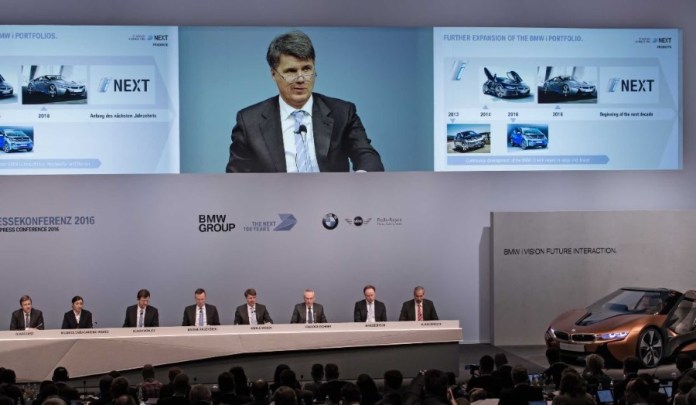
Intel Realises Self Driving Car Market is too big to be Missed
This partnership makes sense not just for BMW but also for Intel.
The latter has been keen to gain a foothold in the autonomous sector having so far been edged out of the race to supply autonomous processing power and automotive silicon solutions by rival companies such as NXP and NVidia.
Towards the end of 2016, Intel created the Autonomous Driving Group and subsequently committed $250M to autonomous technology investments via the company’s its Intel Capital arm.
Intel followed this up in March 2017 with the $15.3B acquisition of Mobileye.
Prior to this investment, Mobileye had already been part of a number of autonomous related partnerships through its Road Experience Management (REM) mapping platform.
This program saw Mobileye collaborate with a number of large motor companies such as Nissan and VW in they are launching self driving taxis.
Fiat Chrysler has also recently joined this collaboration. They aim to have public accessible self driving cars operating on roads by the end of 2021.
The umbrella organisation under which BMW operates acquired Nokia’s HERE mapping assets for $3.1B. This was again done with the goal of helping BMW and Volvo realise self driving car.
Dedicated Autonomous Driving Campus
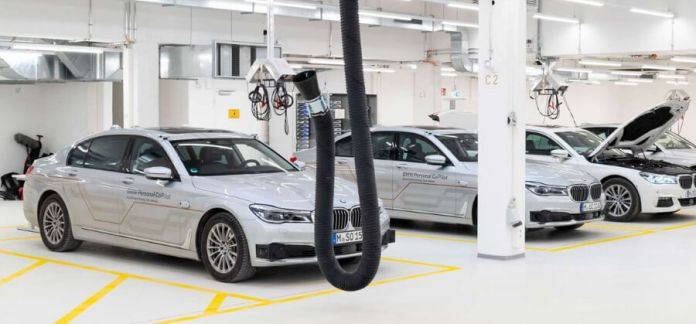
The autonomous driving campus which was opened by BMW in 2018 on a site near Munich in Germany allows the company to work on self driving cars and other related projects.
It is the second workplace created by BMW that is dedicated to autonomous technology alongside. Previously the company opened an office in Mountain View, California.
Currently, BMW has around 40 self driving cars on the roads of Munich and California, these are operating at Level 4 autonomy.
Currently, according to Elmar Frickenstein, BMW’s senior vice president for autonomous driving, the company is confident of having Level 3 self driving cars available by their 2021 deadline.
They remain hopeful that they will be able to deliver Level 4 or 5 self driving cars by 2021. Regardless of whether BMW meets these goals regulatory and infrastructure concerns could delay any mass rollout.
Continental AG

Continental AG, a major auto supply company based in Germany, has taken the slow but steady approach to growing its own program dedicated to self driving cars.
This cautious approach means that the company has so far only committed itself to a vague sometime in the “2020s” deadline for rolling out its autonomous products.
Instead if racing fully after autonomous cars the company is focusing instead on rolling out a series of driver-assist technologies such as the “Cruising Chauffer” system.
2017 saw Continental AG expanding its research operations in Silicon Valley by opening a research and development lab in San Jose.
The work at this lab is focused on developing self driving cars that are capable of communicating with smart roadway infrastructure as well as other autonomous cars.
Continental AG further underlined its commitment to the autonomous sector by committing $300m to expanding hybrid vehicle and electric vehicle technologies.
Continental AG has also entered into a partnership with Nvidia. The aim of this collaboration is to create self driving systems that can be used in a range of vehicles.
This technology will combine the automobile software engineering skills that Continental AG is renowned for with Nvidia’s Drive platform and operating system.
Eventually, the two companies hope to develop independent autonomous technology.
This will then be sold to other car manufacturers to be grafted onto their existing products producing cars with self driving capabilities.
It is thought when fully worked out, that this will be a relatively cheap and quick process compared to more expensive autonomous options.
Daimler

Daimler intends to have fully self driving cars, that is vehicles that are capable of either Level 4 or level 5 autonomy, operating on the public roads at some point in the early 2020s.
To further this goal they have entered into a high profile collaboration with major parts supplier Bosch.
Head of development at Daimler, Ola Källenius, predicts that Daimler will begin large scale commercial production of autonomous cars at some point between 2020 and 2025.
Obviously Daimler isn’t plunging straight into Level 4 or 5 autonomy. They aim to introduce Level 3 autonomy to various models by 2021.
Daimler has already had some success in this field. In April 2016 Daimler’s autonomous trucks were part of a convoy of self driving trucks that successfully completed a cross-border trip.

Further to this since 2015 Daimler has been testing their own autonomous trucks on the roads of Nevada.
In 2017 Daimler successfully repeated the autonomous truck convoy experiment on various highways in Oregon and Nevada.
This meant that the company’s “Freightliner Inspiration Truck” was the first autonomous trucks to be allowed to drive on Nevada’s public highways.
Away from autonomous trucks, Daimler has announced a partnership with Uber.
During the next few years, this will see Daimler’s self driving cars being introduced onto Uber’s popular rideshare platform in the coming years.
This signals that Daimler, like many other car manufacturers, see the mobility service as a natural starting point for introducing the public to self driving cars.
Didi Chuxing
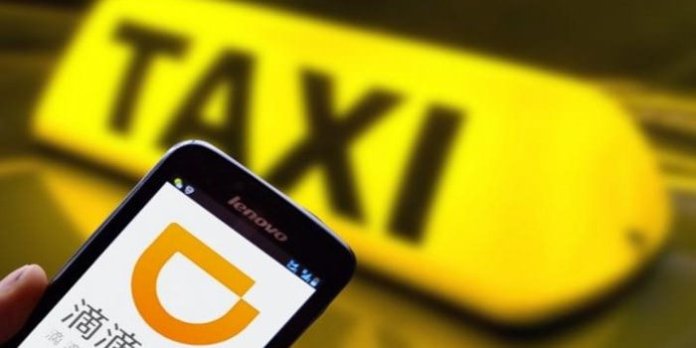
Didi Chuxing is the Chinese rivals to major ride sharing platform Uber. In fact, the company has such a large share of the Chinese market that it has absorbed Uber’s Chinese division.
As Uber looks towards self driving cars as the future of its service Didi Chuxing is https://www.bloomberg.com/features/2016-didi-cheng-wei/determined not to be left behind.
March 2017 saw Didi Chuxing opening their own artificial intelligence lab in Silicon Valley.
The main focus of the lab is research and development, in particular, they are aiming to create intelligent driving systems.
The company is also looking at various artificial intelligence-based applications to improve transportation security.
To further this goal Didi Chuxing has recruited a series of skilled engineers to drive the work in their artificial intelligence lab.
These include Jia Zhaoyin, the former senior software engineer at Waymo, and Charlie Miller who had previously worked on autonomous vehicle security for Uber.
Didi Chuxing has also partnered up with Udacity on a program that sees them hiring graduates from Udacity’s self driving “nanodegree” program.
In 2017 Udacity and Didi Chuxing further cemented their partnership by announcing a joint competition focused on self driving technology, safety and similar solutions.
The teams that are judged to have developed the best “automated safety and awareness processing stack” can earn themselves a prize of $100k.
2018 saw Didi Chuxing revealing that it had successfully developed and tested a fully functional self driving car.
The company also announced that this had been completed in partnership with a range of carmakers and suppliers.
May 2018 saw Didi Chuxing being granted permission by the California DMV to start testing their self driving cars on the state’s public roads and highways.
Ford

Compared to their counterparts in the motor industry Ford has been relatively slow to embark on their quest for self driving cars. Despite an initial reluctance the company is now making up for lost time and investing heavily.
In 2015 Ford unveiled its “Smart Mobility Plan”. This is intended to launch the company into innovative areas of the industry, such as connectivity and self driving cars.
In March 2016 the Ford Smart Mobility LLC was launched. This subsidiary is focusing its efforts on developing and testing self driving cars, autonomous mobility services and connectivity.
Further accelerating Ford’s drive into self driving cars and related opportunities Ford has separated its self driving car development program from the rest of the company, forming a new company called Ford Autonomous Vehicles.
The company’s 10 year autonomous vehicle plan has also seen Ford announcing plans to triple its test fleet to 30 total vehicles in 2016. As further developments are made this test fleet will only grow in size.
Much of Ford’s work in the autonomous sector has seen the company leading the way in testing self driving cars in difficult weather conditions such as snow or on darkened roads.
By 2021 Ford aims to have delivered self driving cars with pre-mapped or “geofenced” areas.
Ford has been able to quickly gain pace with its rivals thanks to the company’s policy of investing in and acquiring startups and smaller companies already working in artificial intelligence solutions, mapping and lidar.
One of Ford’s most significant acquisitions came in 2017 when they purchased a majority stake in Argo, an AI startup.
2018 saw Ford testing Argo developed technology in their third generation Fusion model sedan. Once developed Ford intends to initially use these vehicles on various ride hailing applications.
Ford has also announced a partnership with Domino’s PIzza. This will see the two companies working together to develop a fleet of autonomous pizza delivery vehicles.
A similar partnership with Postmates will see Ford developing on-demand autonomous delivery solutions.
GM

2016 saw General Motors, or GM for short, making a series of acquisitions and investments in the artificial intelligence development and autonomous vehicle sectors.
Amongst these significant acquisitions was the purchase of Cruise Automation, a startup focused on self driving cars, for a reported $581 million.
GM has further underlined their commitment to the autonomous sector by announcing plans to build a research and development facility for Cruise Automation.
This expansion will also enable Cruise Automation taking on over 1,000 new, skilled employees.

In contrast to many of their rival large car manufacturers, GM has not set out a specific timeline for the development of their own self driving cars.
However, their aggressive approach suggests that the company will achieve autonomous transportation in some form sooner rather than later.
GM CEO Mary Barra wrote, “We expect to be the first high-volume auto manufacturer to build fully autonomous vehicles in a mass-production assembly plant.”
Similar to many other car manufacturers GM is focusing initially on delivering autonomous ride-sharing solutions instead of rolling out a range self driving cars to the general public.
While GM may claim that their focus is on autonomous ride-sharing services Reuters has reported that GM is also working on plans to release thousands of self-driving electric cars onto public roads in the near future.
Initially these would not be consumer-available vehicles. Instead, the self driving vehicles would be delivered as part of GM’s partnership with the ride-sharing operation Lyft Inc.
GM has a 9% stake in Lyft, this was acquired as part of the GM’s plan to create an integrated network of on-demand autonomous vehicles.
Like Waymo, GM is also piloting self driving cars that have no steering wheels or pedals, meaning that artificial intelligence is completely in control.
GM has already unveiled it’s Chevy Bolt, a self driving car which is able to navigate the crowded streets of San Francisco at speeds of up to 25 mph.
Honda

Honda has recently been in discussions with Waymo. If this partnership is formalized the arrangement will probably lead to Waymo’s self driving technology being used in all Honda vehicles.
Honda has held a long term goal of having self driving cars on the streets of Japan by 2020.
This is timed to coincide with Tokyo holding the Summer Olympics and is part of a wider goal that many major Japanese technology and AI firms are working towards.
The Japanese nation intends to use the hosting of the Summer Olympics to showcase not just their accomplishments in the sporting world but also their skills in the technological and autonomous industries.
As they work towards 2020 Honda is now approved to test self driving cars and other autonomous vehicles on the streets of California.
However as with other companies there are strict restrictions on the number of vehicles that can be tested as well as the level of autonomy with which they can operate.
Currently Honda is benefitting from the use of the GoMentum Station platform, like Apple, to test its fleet of self driving cars.
As Honda works towards fully autonomous cars even their basic models are reaping the benefits. For example, the entry-level Civic comes with ADAS, Honda’s semi-autonomous advanced driver assistance system.
This offers drivers a range of safety benefits including adaptive cruise control and automatic braking.
Huawei

Huawei may not be the first name that comes to mind when you think of cars but that hasn’t stopped the Chinese based telecommunication giant from ploughing some of their considerable resources into developing self driving cars.
In 2016 Huawei published a white paper which detailed how they thought mobile network operators could play a role in autonomous transport. Huawei believes that they, as well as similar companies, can play a key role in providing connectivity to cars.
This role can benefit self driving cars and other forms of autonomous transport in a variety of different ways such as smart or assisted parking, in-car data gathering which can then be remotely uploaded to a cloud, and LTE based emergency services.
The 2017 Mobile World Congress in Barcelona saw Huawei teaming up with Vodafone to showcase the latest developments in this field.
This included Cellular V2X, a piece of cellular technology which is able to connect to self driving cars.
At the same conference the following year Huawei revealed Porsche Panamera which had been kitted out with the company’s Mate 10 Pro technology.
This meant that the Porsche was able to perform object recognition, this is a vital feature for self driving cars.
Huawei’s development saw the Mate 10 Pro smartphone steering the car. The technology was also able to differentiate between cars and people as well as inanimate objects.
This allowed the Porsche to drive smoothly without any collisions.
Many industry observers believe however that this is not so much Huawei making its play for a piece of the potentially lucrative self driving cars market but more as a means of showing off the company’s AI capabilities.
Hyundai
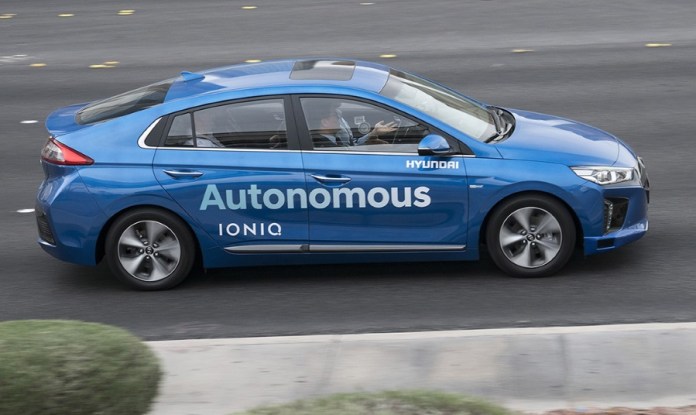
When it comes to self driving cars Hyundai is staying true to the philosophy that it has long since applied to more traditional forms of automobiles.
In other words it is aiming to provide affordable autonomous vehicles to the mass market.
While there is no set timescale for this Thomas Schmid, Hyundai’s head of operations in Europe has said that self driving cars would come “by far not as quick as everyone says,”.
Despite Schmid’s caution, Hyundai has intensified its efforts to develop self driving cars in recent years. This has seen the company investing in various AI businesses and startups such as Aurora.
This is a startup focused on developing autonomous technology. Hyundai has also established a new business unit, the goal of which is to develop both self driving and “hyper connected” cars as quickly as possible.
Hyundai is also working towards an autonomous SUV. It hopes to be road testing the technology by 2021 at the latest, with the finished product entering the market in 2025.
There is currently a low level of autonomous safety in some Hyundai vehicles. The company’s next generation safety system allows drivers the ability to safely remove their hands from the wheel for 15 seconds.
Another investment, this time in Autotalks, an Israeli company which builds between car communication systems, highlights the importance that Hyundai is placing on self driving cars.
It also signals the importance to the company of the importance of creating advanced detection and sensor systems in its cars.
Hyundai has recently agreed a partnership with Russian internet giant Yandex to develop autonomous vehicle components.
The deal marks Yandex’s first OEM collaboration and comes after the South Korean automobile manufacturer‘s considerable investment in Ola, an India-based ride-hailing entity.
The agreement to develop the control systems for both level 4 and 5 vehicles, which are the automation categories described by the Society of Automotive Engineers’ as requiring zero or limited human intervention.
Jaguar Land Rover

British firm Jaguar Land Rover may never be an obvious light in the drive towards self driving cars.
In fact, Wolfgang Epple, Jaguar Land Rover’s Director of Research and Technology, even stated that the trend in the push for autonomous cars to treat passengers as cargo runs contrary to the brand’s philosophy.
Instead of developing self driving cars Epple, insisted that Jaguar Land Rover, as well as other Tata-owned companies, would look towards advanced assistance features that would improve the driver experience.
This firm stance may lead you to think that Jaguar Land Rover had completely ruled out the possibility of ploughing resources into the development of autonomous technology.
However, in February 2016 Jaguar Land Rover became part of a $7.9m program in the UK that intends to further research and development into autonomous driving.
The program also aims to carry out work on vehicle communications technology as well as gathering data on, and analysing, drivers habits.
Further to this Jaguar Land Rover have also finalised plans to develop a fleet of around 100 research vehicles.
This project will last until at least 2020 and will see self driving cars as well as connected car technology being tested on Britain’s roads.
In March 2018 Jaguar Land Rover entered into a partnership with Waymo. This project will lead to up to 20,000 Jaguar I-Pace cars, which will be both electric and autonomous, joining Waymo’s taxi service.
These are still some way off as production won’t being in earnest until 2020.
Jaguar Land Rover is also working on applications to enable self driving cars to function in off-road scenarios.
Lyft
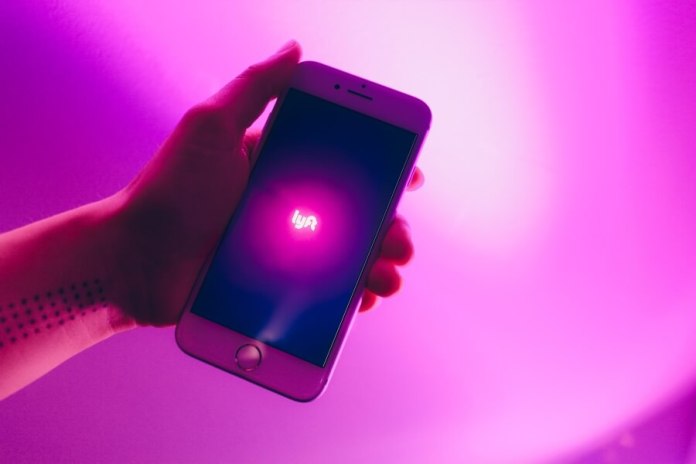
On-demand transportation service Lyft launched in 2012. Based in San Francisco, California, the company operates in around 300 U.S. cities, providing over 1 million rides a day.
Lyft has also expanded into other territories such as Canada, meaning that it is now becoming a major rival to the already significant player in this field, Uber.
Lyft has also benefited from a $500m investment by General Motors. Together the two companies are working to bring self driving cars to the public.
This will see Lyft using GMs Chevy Bolt self driving cars to transport customers around various American cities.
The Lyft and GM deal is not exclusive, however. Lyft also has a partnership with Waymo.
This will see the two companies working together on research and development projects as well as testing self driving cars and similar autonomous technology both in private and on public roads in various locations around America.
Mercedes and Bosch
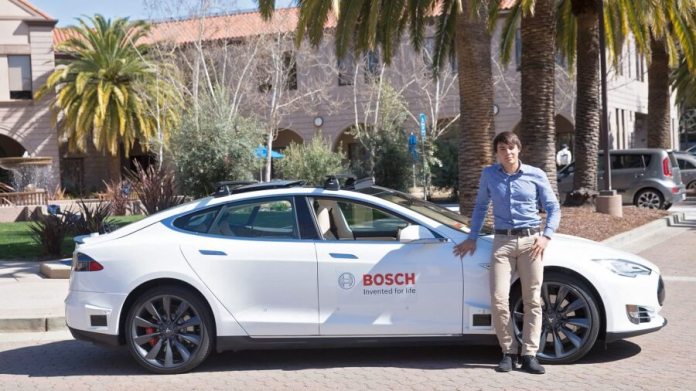
Not wishing to be left behind in the race to realising self driving cars on public roads one of the world’s largest automotive suppliers, Bosch, has dedicated over 2,000 engineers to the task of creating reliable driver-assistance systems.
Additionally, the company is partnering Tom Tom, the noted GPS provider.
This partnership will enable Bosch to access large swathes of mapping data and speed up their progress towards driver-assistance systems.
This collaboration between the two companies has so far led to the pioneering radar localisation map layering.
Mercedes, like other luxury car brands, is working towards providing self driving abilities on many of its newer cars.
However initial progress has been slow, 2017’s Mercedes- E-Class was only capable of Level 2 automation.
In the hope of speeding up their development of self driving cars in April 2017, Mercedes entered into a partnership with Bosch.
The two companies aim to develop first Level 4 self driving cars and then vehicles that are capable of Level 5 autonomy.
Once this goal is achieved Mercedes will have 2 years exclusivity on the autonomous technology before it is then offered to other vehicle manufacturers.
Mercedes and Bosch are confident that their self driving cars will be on the roads by 2020.
Nissan/Renault

The New York Auto Show in 2016 saw Carlos Ghosn, then Chairman and CEO of Nissan and Renault, announced that by 2020 the group would have 10 vehicles that are capable of “significant autonomous functionality” on sale to the general public.
Following up on this announcement 2017 saw Nissan begin a series of tests involving autonomous cars navigating the roads in and around Tokyo.
To further their goal of achieving Level 5 automation or, to put it another way, completely self driving cars, Nissan and Renault have entered into a partnership with Toyota.
This joint effort aims to develop standardized “intelligent” maps. If successful it will help the Nissan and Renault brands take a significant step towards delivering autonomous transportation.
2017 also saw Nissan and Renault joining Mobileye’s crowdsourced autonomous vehicle mapping project.
When Nissan and Renault eventually achieve full self driving cars it is likely that Mobileye will play a big part in the success.
Mobileye’s ProPilot system already powers many of the Nissan and Renault’s semi- autonomous cars.
2018 saw Nissan entering into a partnership with deNA a Japanese online game and e-commerce firm.
Together they plan on delivering a self driving taxi service, Easy Ride.
Public trials have already been conducted in the Japanese city of Yokohama.
These saw members of the public successfully being taken to their destinations in a self driving modified Nissan Leaf electric car.
Nvidia and Paccar

The 2016 CES saw Nvidia, traditionally a GPU and semiconductor focused company, unveil their Nvidia Drive PX2.
This is the second generation of Nvidia’s self-driving car platform.
The Nvidia Drive PX2 boasts 8 teraflops of processing power.
The platform is expressly designed for computer vision applications, sensor fusion and various deep learning applications.
In other words, all the key features needed to create self-driving cars.
Reuters has reported that around 320 companies working towards self-driving cars are using Nvidia Drive in some way.

It is clear that the Nvidia Drive is helping both large car manufacturers and smaller startups in their research and development activities and consequently speeding up the production of autonomous vehicles.
Nvidia’s commitment and understanding of autonomous technology and mastery of self-driving platforms have led to the company forming partnerships with a series of interested parties such as Baidu, Bosch and Tesla.
Nvidia’s Xavier, a system on a chip, is built into brand new Volta architecture.
Once implemented it promises to improve processing power and efficiency, thus improving and enhancing autonomous technology.
Significantly Nvidia has also entered into a partnership with PACCAR a truck maker. This will see the two companies working together to develop a fleet of self-driving trucks.
Jen-Hsun Huang has stated that Nvidia sees a major opportunity for itself in the application of autonomous technology in the world of transport and logistics.
PSA Groupe (Peugeot, Citroën, Vauxhall & Opel)

French multinational car manufacturer PSA Groupe produces some of the biggest car brands in the world, including Peugeot, Citroën, Vauxhall and Opel.
Not wishing to lose the large market share that they currently possess PSA Groupe is always looking to embrace and harness new initiatives and technologies. This includes self driving cars.
In 2016 PSA Groupe announced that two of its Citroën brand cars had driven autonomously, without any human driver intervention, on authorised roads all the way from Paris to Amsterdam.
This is a journey of over 186 miles. With this announcement, PSA Groupe revealed that its cars had achieved Level 3 automation.
Following on from this journey PSA Groupe has further developed its “eyes off” mode. They hope to make this publically available by the end of 2021.
If this is successful the “hands off” semi-autonomous mode will be available by the end of 2020 at the latest.
PSA sees self driving cars, as well as electric vehicles, as the basis for its broader growth strategy, dubbed “Push to Pass.”
In 2017 Peugeot, part of the PSA Groupe, announced a partnership with nuTonomy, the MIT founded self driving focused company.
This collaboration will lead to nuTommy’s self driving systems being incorporated into Peugeot’s 3008 cars.
SAIC Motor

Chinese motor manufacturers SAIC Motor is a leading player in autonomous driving.
Despite being the first car maker to be granted a Chinese licence permitting self driving cars on the road they have not been content to rest on their laurels.
The company is consistently looking for ways to push autonomous technology forward.
To further this goal SAIC Motor has entered into a partnership with Intel which will see a new chip, one which combines Mobileye and Intel technology, being used in their products.
The Mobileye EyeQ5 is an energy efficient chip that is powered by Intel’s Atom C3xx4 processor.
The SAIC Motor and Intel collaboration will also see SAIC cars being fitted with advanced driver assistance systems.
These systems will be capable of navigating traffic and highways with minimal to no human intervention.
They will also be able to break in an emergency situation. The technology is the same as the self driving technology that NIO, another Chinese company, integrated into its SUV ES8.
Data gathered by their self driving cars via cameras and other measuring devices placed in their autonomous cars, will then be fed back to Mobileye’s Road Experience Management technology.
In return, SAIC’s autonomous cars will be able to access crowdsourced data on weather, road conditions, road closures and other potential hazards.
SAIC Motors has so far not only successfully produced two generations of self driving cars but they have also created a 5G telematics platform.
Additionally, the company has completed a series of tests of self driving cars on a series of highways, suburban and urban areas.
Samsung
 Korean tech giants Samsung are making waves in the autonomous driving world.
Korean tech giants Samsung are making waves in the autonomous driving world.
May 2017 saw the company being granted a license to test self driving cars on the public roads of South Korea.
The self driving cars that Samsung have been testing are based on Hyundai vehicles and kitted out with a range of sensors and camera.
Samsung has also purchased Harman, a prominent supplier of connected systems and in-car technology.
This technology will be used by Samsung in future generations of their self driving cars.
2018 CES saw Samsung revealing a number of innovations including a new platform intended to aid the construction of customised autonomous vehicles.
The first product to be released from this platform will reportedly be Drvline, a camera that is capable of warning of potential lane departures, collisions and pedestrians.
The vehicle will also be capable of a degree of cruise control.
Drvline is already being used in self driving test cars on the roads of Korea and California. Once fully tested the product is expected to enter mass production at some time during 2020.
Meanwhile, Samsung acquisition Harman has been working with Rinspeed, a Swiss car manufacturer, to develop the Rinspeed SNAP.
Designed for Level 5 autonomous driving the car is designed to have no steering wheel. Instead, the self driving car consists of a chassis with a detachable passenger pod.
This is intended to give the user a personalised experience where they can use their travel time to rest or consume media.
The car could potentially be on the road by 2025.
SoftBank

Japan-based multinational holding conglomerate SoftBank has entered into the world of self driving cars with SB Drive.
This an autonomous vehicle venture is being driven by a partnership between SoftBank and Advanced Smart Mobility, a research company.
In 2017 this venture received a further boost when Yahoo Japan invested $4.4m into the project.
SB Drive is currently focusing its efforts concerning autonomous technology with a drive towards self driving community and public services.
This includes autonomous buses and other mass transportation solutions. SB Drive aims to have their buses commercially available by the end of 2020.
As they work towards this goal SB Drive has been carrying out a series of tests and trial runs of their self driving buses.
They have also been exploring the commercial viability of operating fixed route buses. It is thought these will mainly benefit community focused public transportation schemes.
Additionally, SB Drive has been exploring the possibilities of autonomous trucks for the purposes of freight delivery.
The success of initial trials has led to SB Drive and four Japanese municipalities entering into smart mobility partnership agreements.
Tata

Tata Elxsi is a division of Tata Group, the Indian multinational conglomerate holding company. Early in 2015 Tata Elxsi revealed their self driving parking valet technology.
This sees the car being able to recognise available parking spaces. When a space is identified the car, with the aid of a system of sensors, is able to park itself safely.
It is unclear whether this feature will make it into the generally available Tata Elxsi range. However, its development shows that Tata Elxsi is committed to developing self driving cars.
This is not the only area that Tata Elxsi are focusing their efforts. The company has also placed a lot of time and effort on the importance of security in autonomous vehicles.
This has led to them developing a central unit which boasts extensive security measures governing both external and internal communication.
In June 2017 Tata Elxsi licensed Autonomai to one of the top five OEMs. AUtonomai is a middleware AV platform.
The Autonomai software will connect hardware, radar systems, cameras and other measuring devices with machine learning algorithms and similar AI applications.
This system will train AVs to operate safely in complex driving scenarios.
Tencent

Chinese technology and cultural enterprise company Tencent states their mission as aiming to “improve the quality of life through internet value added services.”
It is looking to apply these values to its venture into the world of self driving cars.
Like many other autonomous car manufacturers, Tencent has established a hub in Silicon Valley. However, they are yet to actually begin testing any vehicles on the Californian roads.
While they are yet to hit the roads of California Tencent have reportedly been given permission to begin test driving self driving cars around the roads of its Chinese headquarters in Shenzhen.
Tesla

Tesla is a prominent name in the quest for autonomous transport.
The company was also one of the early developers in the field. As early as 2014 they had published “Autopilot” software which equipped their Model S vehicles with a sophisticated degree of autopilot ability.
While not fully self driving cars with Autopilot were able to steer, park and change lane without human interference.
However this rush to be the first meant that Tesla neglected safety and their vehicles were involved in a number of incidents including fatalities.
Undaunted, however, Tesla has pushed on with its quest to develop self driving cars. The Autopilot Hardware 2 is a sensor and computing package that Tesla claims will enable “full self driving” capabilities.
Based on Nvidia’s Drive PX2 platform the system received a series of poor reviews when first released.
However improvements were made and Autopilot Hardware 3 is now due to be released at some time in 2019.
Despite continuing to push ahead with self driving cars Tesla, more than any other autonomous car manufacturer it seems, is involved in incident and accidents.
Many suspect that this is because Tesla has so far refused to employ the Lidar systems that their competitors use. Instead they are developing their own imagining systems.
Once realised these imaging systems will see cameras with advanced image recognition software that enables the car to read the signs and effectively see the road ahead of it.
Elon Musk, CEO of Tesla, has acknowledged that the Tesla option is the more difficult to develop but should they be successful they will be close to or will have achieved full autonomy.
“They’re going to have a whole bunch of expensive equipment, most of which makes the car expensive, ugly and unnecessary,” Musk told analysts in February. “And I think they will find themselves at a competitive disadvantage.”
Unless progress is hampered by further incidents Tesla aims to have Level 4 autonomous cars on the road by 2020.
MORE – Essential Enterprise AI Companies Landscape
Toyota
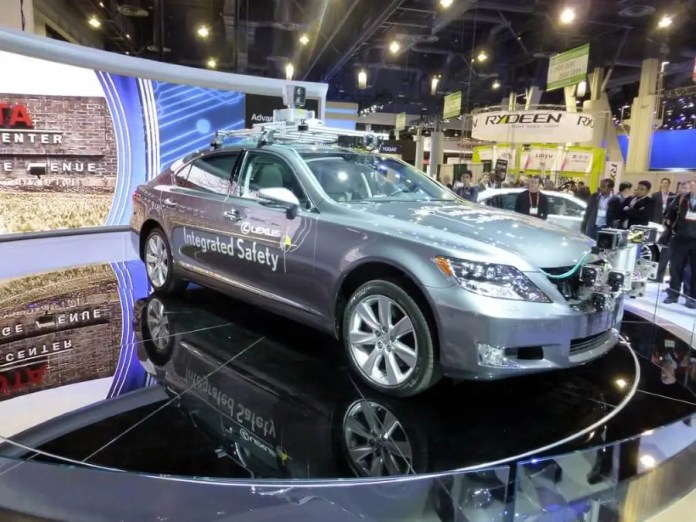
In 2014 Toyota claimed that it had no interest in developing self driving cars on safety grounds.
However the following year the company announced a $1B budget for an autonomous driving research program. This saw the establishment of the Toyota Research Institute, or TRI for short.
Headed by Gill Pratt the TRI hired a number of researchers and professors from MIT, Stanford University and many of the employees of Jaybridge Robotics, an autonomous car development company.
Toyota also entered into a partnership with a number of US universities, most significantly the University of Michigan. This institution has a long and prestigious engineering history.
Pratt, CEO of the TRI, is an advocate of the “guardian angel” system of autonomous cars. This means that the vehicle monitors the driver’s actions and intervenes when it thinks that the driver is about to make a mistake.
TRI is also researching “Chauffeur”. This program is working towards the more conventional Level 4 or Level 5 autonomy.
2018 saw Toyota reveal not only its latest self driving car but also a new company. TRI-AD, or the Toyota Research Institute Advanced Development.
This division is intended to speed up Toyota’s progress towards testing self driving, electric cars. They hope to achieve this goal in time for the Tokyo Olympics in 2020.
Toyota are also working with Uber to bring self driving cars to the ride sharing market.
Toyota aims to do this by introducing its autonomous technology into specially built vehicles. Once completed these will be used on Uber’s existing network. Initial trials are expected to begin in 2021.
Uber

Ride sharing company Uber are major players in the push towards self driving cars.
Not only are they in partnership with many significant car manufacturers, such as Toyota, but they have also partnered with autonomous application developers such as the Arizona State University.
This partnership will see the two working together to develop better optical safety technology and more complete mapping systems.
Uber is not solely focusing their efforts on self driving cars.
In 2016 they acquired Otto, a self driving truck startup.
Uber’s testing has not been without incident. There have been reports of driverless Uber cars entering bike lanes, narrowly avoiding collisions and, sadly, being involved in a fatal accident in Arizona.
Following these incidents, Uber took a number of safety measures including temporarily suspending trials of their self driving cars.
Meanwhile, Uber’s self driving trucks are also now operating on the roads of Arizona. A video released by the company shows the trucks in action but, as of the time of writing, little else in the way of detail has been confirmed.
Looking towards the future Uber has agreed to a non-exclusive deal with car manufacturer Volvo to acquire “tens of thousands” of self driving cars over the next few years.
Uber is also planning to buy “tens of thousands” of self-driving cars from Volvo. An estimate by the Financial Times valued the deal at potentially $1.4 billion.
Uber and Volvo are also collaborating on a scheme to develop autonomous systems for the XC90 SUVs.
Since 2016 Uber has also been in a partnership with Google, Ford, Lyft and Volvo.
The companies hope that by collaborating and sharing their data it will speed up the process of developing fully autonomous transportation.
Valeo

French-based global automotive supplier Valeo has, like many other companies, been working on their own self driving and driver assistance systems.
The company has predicted that autonomous driving will be their main growth area by 2020.
The CES of 2017 saw Valeo revealing its eCruise4U driver assistance system. This came equipped with connected camera, laser driven sensors and a cockpit that can be reconfigured to suit the user.
Valeo’s push into self driving technology, a venture in which they are partnered by major innovators Mobileye, has seen their sales rise.
Mobileye and Valeo made an agreement in 2015, which still stands, to build an affordable robot car. This car, once completed will contain Valeo’s lidar units and Mobileye’s camera vision developments.
At the CES of 2018 Valeo revealed a new in-car passenger identification system. This means that the car is able to recognise the passengers and can then adjust the cars interior to suit their needs and preferences.
Much of Valeo’s development work is done by their research and development team in Tuam, Ireland.
The company recently announced a partnership with Lero, an Irish software company, to create a series of durable autonomous vehicle sensors.
The weather conditions in Ireland, where much of the testing is done, means that Valeo and Lero hope they will be able to develop self driving cars that are suited to challenging road conditions and are weather resistant.
Volkswagen

Major German car manufacturers Volkswagen operate as part of the VW Group. In March 2016 it was announced, via CEO Matthias Muller, that the organisation was beginning a huge autonomous driving initiative.
Muller said that the aim was to “[bring] these technologies to market faster than the competition.” The VW Group’s head of digitalization said that self-driving cars will be “commonplace” by 2025.
So far not only has the company unveiled its V-Charge project, in 2015, but there are also plans for e-Golf’s to be built that is equipped with 3D mapping and sensors.
This will allow them to locate empty parking spaces and park safely, with minimal to no human intervention. Volkswagen’s technicians aim to have demonstration ready prototypes completed by the end of 2019.
2016 saw Volkswagen reveal their MOIA range. This marked their entry into the growing market of producing autonomous vehicles for shuttle or transportation purposes.

This was followed by the reveal of the “Serdic”. This is a concept for a fully autonomous shuttle which can be used by ride-hailing applications.
Volkswagen’s latest self driving car model is Vizzion. Presented first at the Geneva Motor Show in 2018 the Vizzion has no steering wheel or pedals.
While not strictly a Volkswagen product the car manufacturer Audi is part of the Volkswagen Group.
Many experts agree that the Audi A8 is currently one of the most advanced self driving or autonomous cars to open the market.
Volvo

Another major player in the motor industry world Volvo, owned by Geely, has been placing safety at the centre of their drive into the world of self driving cars.
“IntelliSafe”, the name that Volvo has given to its autonomous cars program, has a goal of recording zero fatalities when they fully roll out their self driving features in publically available cars.
While this safety first approach may mean that Volvo isn’t always at the forefront of autonomous technology they are making great strides.
By 2021 Volvo plans to have 100 Swedish drivers using their self driving cars, in particular, the XC90 SUV.
Further to this Volvo has announced that it will take complete responsibility for the vehicles when they are being driven in autopilot or autonomous mode.
Once this pilot has been rolled out in Sweden Volvo is also looking at introducing its self driving cars to the American and Chinese markets.
It is hoped that this scheme will be fully, or at least partly, introduced by the end of 2021.
Much of this work is being informed by developments made in partnership with Autoliv, a Swedish supplier. The two companies have been working together since the start of 2017, the joint project is named Zenuity.
Zenuity aims to commercialise autonomous cars and driver assist systems.
Once developed and tested Zenuity intend to make this technology available to other car manufacturers.
Interest in this project has been considerable with a number of possible partnerships being discussed.
These include a partnership with Luminar, a lidar startup.
Luminar will be working with Volvo on developing physical, car-mounted sensors as well as associated technology and software.
Volvo’s safety-first approach to self driving cars may mean that they won’t be the first company to make autonomous driving available to the public.
However, the emphasis on safety may mean that in the long term Volvo will be a key player in the world of self driving cars.
Waymo (Alphabet)

Originating as part of Google’s self driving cars project Waymo is a self driving technology development company. It is owned by Alphabet.
After being rebranded as Waymo the project revealed, in February 2017, it’s first self-driving hardware and software product. Custom-designed the products were tested by Chrysler Pacifica and Lyft in various self driving cars and minivans.
Waymo has invested a lot of time into testing their self driving cars and other autonomous vehicles. 2018 has seen Waymos self driving cars covering over 4,000,000 miles.
The majority of this has been on the public roads of America.
Waymo has additionally run an estimated 2.5 billion miles in simulation scenarios. They have also run over 25,000 “problematic scenarios” and conducted 20,000 different individual test track tests.
All this testing is clearly paying off for Waymo. The company reportedly has by far the lowest rate of disengagement.

This means that there are relatively few times on a Waymo journey where an engineer or human driver needs to take control of the self driving car.
This statistic comes from comparing information that all the self driving car companies who test in California, which is many of the major players, are required to release.
Additionally Waymo has an impressive safety record. Again it is significantly better than many of their autonomous developing, Californian counterparts.
For example, over a 12 month period Waymo recorded only three collisions in their self driving cars, the cars covered around 250,000 miles.
In comparison, GM’s self driving cars covered only 132,000 miles and recorded a worrying 22 collisions.
A condition of being granted a licence to test self driving cars in California is that safety details must be disclosed on a regular basis.
Buoyed by this success in August 2018 Waymo began a program which provided the residents of the Phoenix area with a bus service.
This service is conducted by Waymo’s self driving fleet, largely comprising of Chrysler Pacifica minivans.
Waymo’s Chrysler Pacifica minivan fleet also operates on the streets of San Francisco. Here they have reportedly reached full speed on the area’s highways.
Yutong

Not an instantly recognisable name in the world of self driving cars Yutong has, nonetheless, been making significant gains in the sector.
Since 2012 Yutong, a Chinese bus manufacturer, has been working towards introducing driverless buses to the country’s roads.
One of their autonomous buses, which can swap between automatic and manual driving mode, has already successfully navigated its way along an inter-city road in Henan Province in central China.
Yutong has not achieved this remarkable feat solely on their own.
Various autonomous vehicle experts such as Li Deyi, an academic from the Chinese Academy of Engineers, have aided the company’s drive towards self driving buses.
Tang Wang, DYutong’s Deputy General Engineer, has said that the company’s driverless bus has further stages of development to go through.
This mainly includes basic movement control, driving on average road conditions, and driving on race lanes.
After seeing the success achieved by Yutong in this field, in June 2018 Greyhound Australia began a six month trial of the T12 coach.
While other companies are pushing towards self driving cars Yutong is leading the way in developing autonomous buses.
ZF and Nvidia

German company ZF Friedrichshafen AG, usually shortened to ZF, is a significant auto parts manufacturer.
Their $12.4 billion purchase of Michigan based automated system supplier TRW in 2015 marked ZF’s entry into the autonomous car sector.
This acquisition was only the start. Since then ZF has slowly acquired a number of other companies such as Hella, Sensors GmbH and Ibeo Automotive Systems GmbH.
This expanding portfolio means that ZF now owns companies that work on a range of autonomous vehicle related products such as radar and LiDAR technology.
At 2017’s CES Stefan Sommer, CEO of ZF, announced a partnership with Nvidia.
The aim of this collaboration is to bring Nvidia’s Drive PX 2 AI Computing platform into production on self driving cars. Current estimates expect this platform to start appearing on cars in 2020.
ZF is not alone in this goal or in this collaboration, according to Reuters, 320 companies involved in self driving cars are using Nvidia Drive to enable the production of autonomous vehicles.
At the following years CES Jensen Huang, founder of Nvidia, announced that ZF systems technologies will be used to create a fully self driving car platform for the Chinese market.
This will see ProAI car computer being combined with Baidu’s Apollo autonomous platform and Nvidia’s new DRIVE Xavier technology.
As we have seen from this list it is not just newcomers to the motoring or technology industries that are driving the push towards self driving cars.
Many of the established brands are also making significant investments and developments.
While some are racing to achieve full autonomy as quickly as possible others, such as Volvo, are taking a more considered approach, putting safety at the heart of everything that they do.
Autonomous transport is already here, in some form at least.
Whether the industry will ever achieve full autonomy and completely phase out human interaction is debatable.
A lot of work must go into improving systems and safety before that is a tangible possibility.
However, the push for full autonomy has seen many improvements in the driving experience, particularly in the field of safety.
For example applications such as assisted parking sensors and mapping, technologies are increasingly being used in even basic models, making them safer, more reliable and easier to use.
We may still be driving our cars for a while yet but, thanks to the push for autonomous transportation, they will be safer and more reliable than ever before.
Images: Flickr Unsplash Pixabay Wiki & Others



















